计算机导论作业1
- 格式:doc
- 大小:143.00 KB
- 文档页数:9
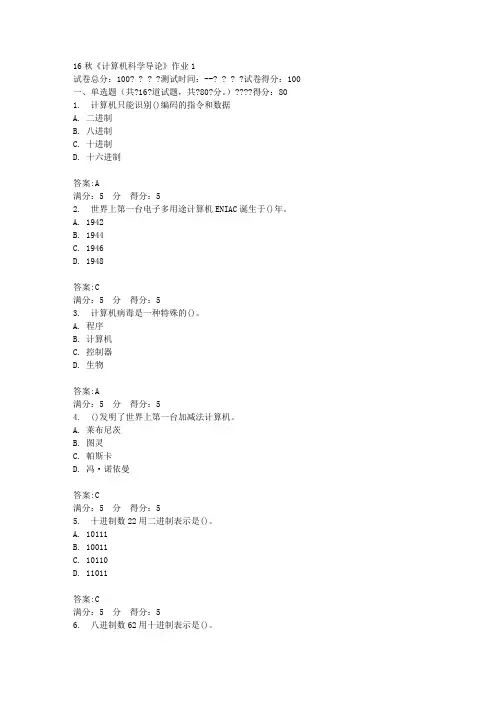
16秋《计算机科学导论》作业1
试卷总分:100? ? ? ?测试时间:--? ? ? ?试卷得分:100
一、单选题(共?16?道试题,共?80?分。
)????得分:80
1. 计算机只能识别()编码的指令和数据
A. 二进制
B. 八进制
C. 十进制
D. 十六进制
答案:A
满分:5 分得分:5
2. 世界上第一台电子多用途计算机ENIAC诞生于()年。
A. 1942
B. 1944
C. 1946
D. 1948
答案:C
满分:5 分得分:5
3. 计算机病毒是一种特殊的()。
A. 程序
B. 计算机
C. 控制器
D. 生物
答案:A
满分:5 分得分:5
4. ()发明了世界上第一台加减法计算机。
A. 莱布尼茨
B. 图灵
C. 帕斯卡
D. 冯·诺依曼
答案:C
满分:5 分得分:5
5. 十进制数22用二进制表示是()。
A. 10111
B. 10011
C. 10110
D. 11011
答案:C
满分:5 分得分:5
6. 八进制数62用十进制表示是()。
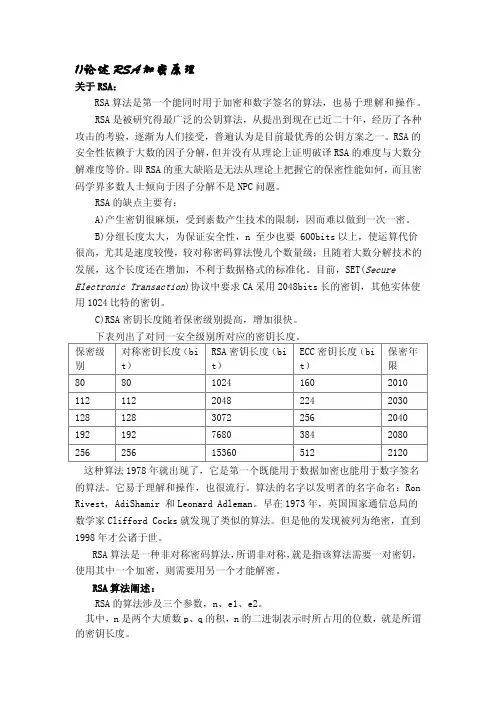
1)论述RSA加密原理关于RSA:RSA算法是第一个能同时用于加密和数字签名的算法,也易于理解和操作。
RSA是被研究得最广泛的公钥算法,从提出到现在已近二十年,经历了各种攻击的考验,逐渐为人们接受,普遍认为是目前最优秀的公钥方案之一。
RSA的安全性依赖于大数的因子分解,但并没有从理论上证明破译RSA的难度与大数分解难度等价。
即RSA的重大缺陷是无法从理论上把握它的保密性能如何,而且密码学界多数人士倾向于因子分解不是NPC问题。
RSA的缺点主要有:A)产生密钥很麻烦,受到素数产生技术的限制,因而难以做到一次一密。
B)分组长度太大,为保证安全性,n 至少也要 600bits以上,使运算代价很高,尤其是速度较慢,较对称密码算法慢几个数量级;且随着大数分解技术的发展,这个长度还在增加,不利于数据格式的标准化。
目前,SET(Secure Electronic Transaction)协议中要求CA采用2048bits长的密钥,其他实体使用1024比特的密钥。
C)RSA密钥长度随着保密级别提高,增加很快。
这种算法1978年就出现了,它是第一个既能用于数据加密也能用于数字签名的算法。
它易于理解和操作,也很流行。
算法的名字以发明者的名字命名:Ron Rivest, AdiShamir 和Leonard Adleman。
早在1973年,英国国家通信总局的数学家Clifford Cocks就发现了类似的算法。
但是他的发现被列为绝密,直到1998年才公诸于世。
RSA算法是一种非对称密码算法,所谓非对称,就是指该算法需要一对密钥,使用其中一个加密,则需要用另一个才能解密。
RSA算法阐述:RSA的算法涉及三个参数,n、e1、e2。
其中,n是两个大质数p、q的积,n的二进制表示时所占用的位数,就是所谓的密钥长度。
e1和e2是一对相关的值,e1可以任意取,但要求e1与(p-1)*(q-1)互质;再选择e2,要求(e2*e1)mod((p-1)*(q-1))=1。
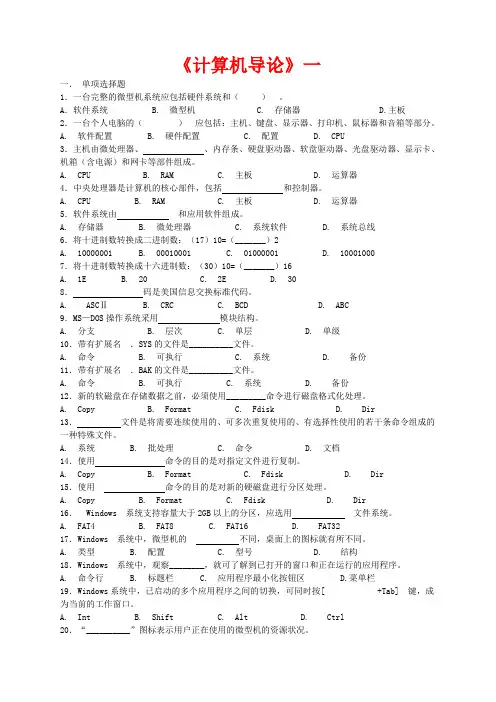
《计算机导论》一一.单项选择题1.一台完整的微型机系统应包括硬件系统和()。
A.软件系统 B. 微型机 C. 存储器 D.主板2.一台个人电脑的()应包括:主机、键盘、显示器、打印机、鼠标器和音箱等部分。
A. 软件配置 B. 硬件配置 C. 配置 D. CPU3.主机由微处理器、、内存条、硬盘驱动器、软盘驱动器、光盘驱动器、显示卡、机箱(含电源)和网卡等部件组成。
A. CPUB. RAMC. 主板D. 运算器4.中央处理器是计算机的核心部件,包括和控制器。
A. CPUB. RAMC. 主板D. 运算器5.软件系统由和应用软件组成。
A. 存储器B. 微处理器C. 系统软件D. 系统总线6.将十进制数转换成二进制数:(17)10=(_______)2A. 10000001B. 00010001C. 01000001D. 100010007.将十进制数转换成十六进制数:(30)10=(_______)16A. 1EB. 20C. 2ED. 308.码是美国信息交换标准代码。
A. ASCⅡB. CRCC. BCDD. ABC9.MS—DOS操作系统采用模块结构。
A. 分支B. 层次C. 单层D. 单级10.带有扩展名.SYS的文件是__________文件。
A. 命令B. 可执行C. 系统D. 备份11.带有扩展名.BAK的文件是__________文件。
A. 命令B. 可执行C. 系统D. 备份12.新的软磁盘在存储数据之前,必须使用_________命令进行磁盘格式化处理。
A. CopyB. FormatC. FdiskD. Dir13.文件是将需要连续使用的、可多次重复使用的、有选择性使用的若干条命令组成的一种特殊文件。
A. 系统B. 批处理C. 命令D. 文档14.使用命令的目的是对指定文件进行复制。
A. CopyB. FormatC. FdiskD. Dir15.使用命令的目的是对新的硬磁盘进行分区处理。
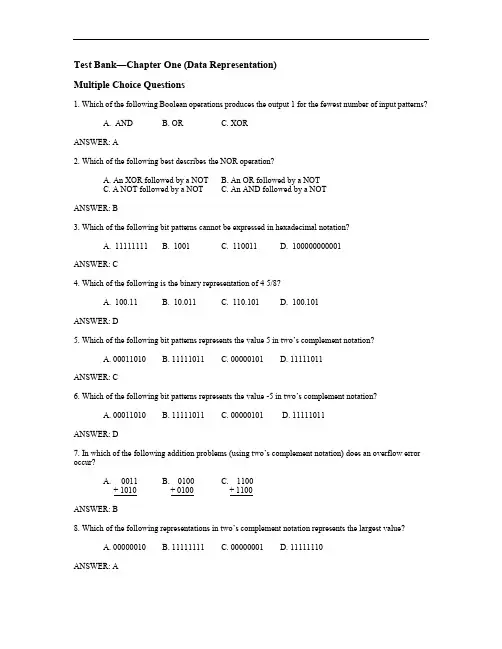
Test Bank—Chapter One (Data Representation)Multiple Choice Questions1. Which of the following Boolean operations produces the output 1 for the fewest number of input patterns?A. ANDB. ORC. XORANSWER: A2. Which of the following best describes the NOR operation?A. An XOR followed by a NOTB. An OR followed by a NOTC. A NOT followed by a NOT C. An AND followed by a NOTANSWER: B3. Which of the following bit patterns cannot be expressed in hexadecimal notation?A. 11111111B. 1001C. 110011D. 100000000001ANSWER: C4. Which of the following is the binary representation of 4 5/8?A. 100.11B. 10.011C. 110.101D. 100.101ANSWER: D5. Which of the following bit patterns represents the value 5 in two’s complement notation?A. 00011010B. 11111011C. 00000101D. 11111011ANSWER: C6. Which of the following bit patterns represents the value -5 in two’s complement notation?A. 00011010B. 11111011C. 00000101D. 11111011ANSWER: D7. In which of the following addition prob lems (using two’s complement notation) does an overflow error occur?A. 0011B. 0100C. 1100+ 1010 + 0100 + 1100ANSWER: B8. Which of the following representations in two’s complement notation represents the largest value?A. 00000010B. 11111111C. 00000001D. 11111110ANSWER: A9. Which of the following bit patterns (represented in hexadecimal notation) represents a negative number in two’s complement notation?A. 7FB. 55C. A6D. 08ANSWER: C10. What value is represented by the bit pattern 01011100 when interpreted using floating-point format in which the most significant bit is the sign bit, the next three bits represent the exponent field in excess notation, and the last four bits represent the mantissa?A. -1 1/2B. 1 1/2C. -3/8D. 3/8ANSWER: B11. Which of the following values cannot be stored accurately using a floating-point format in which the most significant bit is the sign bit, the next three bits represent the exponent field in excess notation, and the last four bits represent the mantissa?A. 2 1/2B. 3/16C. 7D. 6 1/4ANSWER: D121. Which of the following bit-patterns represents the smallest value using the floating-point format in which the most significant bit is the sign bit, the next three bits represent the exponent field in excess notation, and the last four bits represent the mantissa?A. 01001000B. 01011000C. 00101000D. 01111000ANSWER: C13. Which of the following data storage systems provides the most efficient random access to individual data items?A. Main memoryB. Magnetic diskC. Optical CDs and DVDsANSWER: A14. Which of the following storage systems is best suited for storing and retrieving long strings of data that are processed in their sequential order?A. Main memoryB. Magnetic diskC. Optical CDs and DVDsANSWER: C15. Which of the following mass storage system does not require physical motion?A. Magnetic tapeB. Magnetic diskC. DVDsD. Flash drives ANSWER: D16. Assuming that each of the following bit patterns originally had even parity, which one contains an error?A. 10110100B. 11000011C. 00011000D. 10001001 ANSWER: D17. How many errors per pattern could be corrected when using an error-correcting code in which any two code patterns differ by a Hamming distance of 8?A. 3B. 4C. 5D. 6ANSWER: A18. Which of the following is a possible LZW compression of the message “xyz xyz xyz”?A. 1234B. 1234545C. 232D. 12ANSWER: B19. How many different symbols can be encoded using Unicode?A. 256B. 4,096C. 65,536D. 1,046,476ANSWER: C20. Which of the following systems is least efficient when encoding numeric values?A. Two’s complement notationB. Excess notationC. ASCIID. Floating-point notationANSWER: C21. Which of the following is a means of encoding music?A. ASCIIB. MIDIC. JPEGD. GIFANSWER: BFill-in-the-blank/Short-answer Questions1. A computer’s main memory consists of numerous memory cel ls, each of which contains ________ bits. Each memory cell is identified by a numeric value called the cell’s _________.ANSWER: eight, address2. Represent the bit pattern 1011010010011111 in hexadecimal notation._________ANSWER: B49F3. A7DF is the hexadecimal representation for what bit pattern?____________ANSWER: 1010 0111 1101 11114. How many different bit patterns can be formed if each must consist of exactly 6 bits?____________ANSWER: 645. Translate each of the following binary representations into its equivalent base ten representation.A. 1100 __________B. 10.011 __________C. 0.01 __________D. 10001 __________ANSWER: A. 12 B. 2 3/8 C. 1/4 D. 176. Rewrite each of the following values (represented in base ten notation) in binary notation.A. 7 __________B. 23 __________C. 2 1/4 __________D. 5/8 __________ANSWER: A. 111 B. 10111 C. 10.01 D. 0.1017. If the patterns 101.11 and 1.011 represent values in binary notation, what is the binary representation of their sum?____________ANSWER: 111.0018. Using a two’s complement notation system in which each value is represented by a pattern of six bits, represent the value 3.____________ANSWER: 0000119. Using a two’s complemen t notation system in which each value is represented by a pattern of six bits, represent the value -3.____________ANSWER: 11110110. What is the largest positive integer that can be represented in a two’s complement system in which each value is represented by eight bits?____________ANSWER: 127 (represented by 01111111)11. In a two’s complement system, what value is represented by the pattern 11111111111111001?____________ANSWER: -712. When using two’s complement notation, what bit pat tern represents the negation of 01101010?____________ANSWER: 1001011013. What value is represented by each of the following patterns in excess notation?A. 10000 ____B. 0110 ____C. 1011 ____ANSWER: A. 0, B. -2, C. 314. Using an 8-bit floating-point format in which the most significant bit is the sign bit, the next three bits represent the exponent field in excess notation, and the last four bits represent the mantissa, write the bit pattern that represents the value 1 3/4. (Use normalized form.)____________ANSWER: 0101111015. What is the largest value that can be represented in a floating-point system in which each value is encoded by a byte whose most significant bit is the sign bit, the next three bits represent the exponent field in excess notation, and the last four bits represent the mantissa?____________ANSWER: 7 1/2 (represented as 01111111)16. Which of the following addition problems cannot be solved accurately when using a floating-point system in which each value is encoded by a byte whose most significant bit is the sign bit, the next three bits represent the exponent field in excess notation, and the last four bits represent the mantissa?A. 2 1/2 + 1 3/8B. 3 1/2 + 4 1/2C. 7 + 3/4____________ANSWER: A, B, and C17. The following is an error-correcting code in which any two patterns differ by a Hamming distance of at least three.Symbol RepresentationA 000000B 001111C 010011D 011100E 100110F 101001G 110101H 111010Decode each of the following patterns010011 ________ 101010 ________ 011000 ________ 101101 _______ ANSWER: C, H, D, F18. How many errors in a single code pattern could be corrected when using an error-correcting code in which each code pattern is a Hamming distance of at least seven from any other code pattern?____________ANSWER: 319. The following is a message that was originally encoded so that each pattern had odd parity. Circle the patterns in which an error has definitely occurred.10110101 11110000 10010010 00000000 11111111 00001000 00111101______________________________________ANSWER: Second, fourth, fifth, and sixth20. Data compression techniques apply various principles to reduce the size of data. One, called_______________________, avoids repeating long strings of the same data item. Another, called_______________________, encodes the difference between consecutive blocks of data rather than encoding each block in its entirety. Still another, called _________________________, uses short bit patterns to encode frequently occurring items and longer patterns to encode less frequent items. ANSWER: Run-length encoding, relative encoding, and frequency-dependent encoding.Vocabulary (Matching) QuestionsThe following is a list of terms from the chapter along with descriptive phrases that can be used to produce questions (depending on the topics covered in your course) in which the students are ask to match phrases and terms. An example would be a question of the form, “In the blank next to each phrase, write the term from the following list that is best described by the phrase.”Term Descriptive Phrasebit Binary digitBoolean operation AND, OR, XOR, NOTaddress A numeric value used to identify a memory cellhexadecimal notation An efficient way of representing bit patternssector A segment of a track in a mass storage systemzoned-bit recording A means of increasing the storage capacity of a magnetic disk system buffer A storage area used to hold data on a temporary basis, often as a stepin transferring the data from one device to anotherISO An international organization for establishing standardsANSI A major standardization organization within the United StatesASCII A system developed by the American Standards Institute for encodingtext.flip-flop A digital circuit capable of holding a single digittwo’s complement notation A means of encoding whole numbersfloating-point notation A means of encoding numeric values that may involve fractions truncation An error that may occur when using floating-point notationpixel A small part of an imageGIF A means of compressing an image file by restricting the number ofcolors availableJPEG A means of compressing images by blurring the boundaries betweendifferent colors while maintaining all brightness informationUnicode A means of encoding text in which each symbol is represented by 16bitsLZW An example of adaptive dictionary encodingMIDI A means of encoding music in terms of notes and instruments ratherthan actual audioKey field A part of a logical record in a file used to identify the record.VLSI A means of constructing complex circuitry in a very small space.General Format Questions1. Describe how a computer can produce an incorrect answer when performing numerical computations even though it has not malfunctioned.ANSWER: Most students will probably refer to overflow and truncation errors.2. Describe ho the concept of Hamming distance is used to produce an error-correcting code. ANSWER: By designing a code in which each pattern has a Hamming distance of n from any other pattern, patterns with fewer than n/2 errors can be corrected by replacing them with the code pattern that is closest.3. a. What is the output of the circuit below?b. In general, how does the three-bit input pattern acros s the top of the diagram relate to the circuit’s output?ANSWER: a. 0 b. The output is 0 if the input parity is odd; the output is 1 if the input parity is even.4. If the input and output bit patterns in the circuit below are interpreted as binary representations of numeric values, what operation does the circuit perform?ANSWER: The circuit subtracts one (except for the case of the input being 000).5. Explain why such terms as kilobyte, megabyte, and gigabyte have acquired double meanings.ANSWER: The prefixes kilo, mega, and giga are used traditionally to refer to units measured in powers of ten. However, due to the early misuse of the prefix kilo in reference to units of the size 1024, these prefixes are now often used to refer to units that are powers of two—especially when referring to the capacity of main memories.6. Convert the following addition problem into two’s complement notation (using four bits per value), perform the addition, convert the answer back into base ten notation, and explain the results.6+ 3ANSWER: In two’s complement notation the problem is to add 0110 and 0011. The sum is 1001 which translates to -7. This answer is incorrect due to overflow.7. Under what condition is each of the following data compression techniques most effective?a. Run-length encodingb. Relative encodingANSWER: a. Compresses most when data consists of long strings of the same entry.b. Compresses most when each block of data differs little from the previous block.8. What is frequency-dependent encoding?ANSWER: Frequency-dependent encoding is an encoding system that uses short bit patterns to represent data items that occur most often and longer patterns to represent less frequently occurring items. The result is that entire blocks of data can be represented in less space than would be required if each data item were represented by the same size bit pattern.9. Construct the entire two’s complement scale in which each value is represented by three bits.ANSWER: 3 0112 0101 0010 000-1 111-2 110-3 101-4 10010. To what does the term “normalized form” refer in the context of floating-point notation?ANSWER: Normalized form refers to a standard for positioning the bit pattern within the mantissa field. Many values can be represented in floating-point notation by different bit patterns, only one of which is in normalized form. Hence, restricting representations to normalized form assures that each value is represented by a unique pattern.11. Explain why the final version of the dictionary need not be transmitted with a message encoded using LZW compression.ANSWER: The dictionary can be constructed during decompression in the same way it was constructed during compression.12. Among the Boolean operations AND, OR, EXCLUSIVE OR, and NOT, which is least like the others? Explain your answer.ANSWER: There is not really a right or wrong answer. The student’s explanation is the most important part. Most students will probably answer NOT because it has only one input whereas the others have two.13. If a term paper consisted 42 pages, each containing 40 lines of 100 symbols each (counting each space asa symbol), was to be encoded using Unicode, how many bytes of storage space would be required?ANSWER: 336,000 bytes (168,000 symbols times 2 bytes per symbol)14. Explain why adding only a few characters to a text file may increase the file’s size by several hundred bytes and at other times may not increase the file’s s ize at all.ANSWER: File space is allocated in terms of physical records, each of which is several hundred bytes in size. Thus, the size of a file grows by physical record units rather than by byte size units.15. In a two’s complement system, what valu e can be added to any other value without causing an overflow? How many values in the system have this property? Explain your answer.ANSWER: Adding the value 0 to any other value will not produce an overflow. However, if m is the largest positive integer that can be represented in the system, then any value in the range 1 to m will produce an overflow when added to m, and any value in the range -1 to -( m + 1) will produce an overflow when added to -( m + 1).。
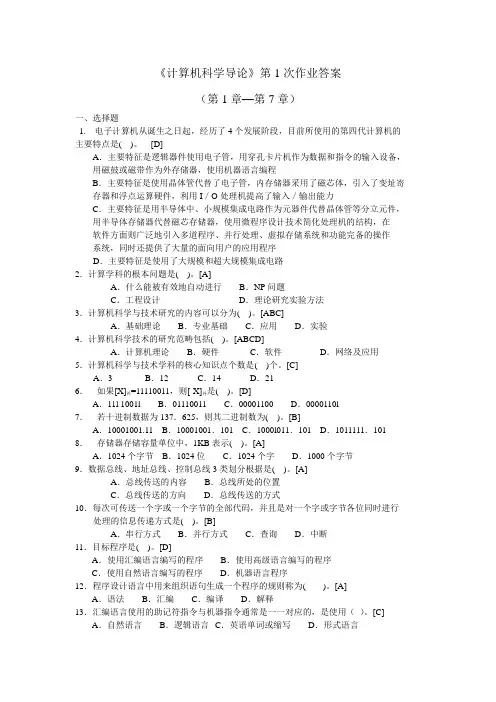
《计算机科学导论》第1次作业答案(第1章—第7章)一、选择题1. 电子计算机从诞生之日起,经历了4个发展阶段,目前所使用的第四代计算机的主要特点是( )。
[D]A.主要特征是逻辑器件使用电子管,用穿孔卡片机作为数据和指令的输入设备,用磁鼓或磁带作为外存储器,使用机器语言编程B.主要特征是使用晶体管代替了电子管,内存储器采用了磁芯体,引入了变址寄存器和浮点运算硬件,利用I/O处理机提高了输入/输出能力C.主要特征是用半导体中、小规模集成电路作为元器件代替晶体管等分立元件,用半导体存储器代替磁芯存储器,使用微程序设计技术简化处理机的结构,在软件方面则广泛地引入多道程序、并行处理、虚拟存储系统和功能完备的操作系统,同时还提供了大量的面向用户的应用程序D.主要特征是使用了大规模和超大规模集成电路2.计算学科的根本问题是( )。
[A]A.什么能被有效地自动进行B.NP问题C.工程设计D.理论研究实验方法3.计算机科学与技术研究的内容可以分为( )。
[ABC]A.基础理论B.专业基础C.应用D.实验4.计算机科学技术的研究范畴包括( )。
[ABCD]A.计算机理论B.硬件C.软件D.网络及应用5.计算机科学与技术学科的核心知识点个数是( )个。
[C]A.3 B.12 C.14 D.216.如果[X]补=11110011,则[-X]补是( )。
[D]A.11l 1001l B.01110011 C.00001100 D.0000110l7.若十进制数据为137.625,则其二进制数为( )。
[B]A.10001001.11 B.10001001.101 C.1000l011.101 D.1011111.101 8.存储器存储容量单位中,1KB表示( )。
[A]A.1024个字节B.1024位C.1024个字D.1000个字节9.数据总线、地址总线、控制总线3类划分根据是( )。
[A]A.总线传送的内容B.总线所处的位置C.总线传送的方向D.总线传送的方式10.每次可传送一个字或一个字节的全部代码,并且是对一个字或字节各位同时进行处理的信息传递方式是( )。
![大学计算机导论习题汇总习题篇[1]](https://uimg.taocdn.com/1fc6370e4a7302768e993931.webp)
第一章计算机及信息技术概述1. 填空题1.英国数学家图灵在1936年提出了对数字计算机具有深远影响的_______________。
匈牙利裔科学家冯.诺依曼提出了数字计算机的_____________________。
2.冯.诺依曼结构计算机的三个重要思想是_________________、_____________和_____________。
3.按特定顺序排列,使计算机能执行某种任务的指令的集合称为____________。
由二进制编码构成的程序语言是__________语言。
4.随着电子技术的发展,计算机先后以________、________、________、________为主要元器件,共经历了4代变革。
5.今后计算机的发展方向趋向于________、________、________、________。
6.根据软件的用途,计算机软件可以分为________________和________________两类。
7.当数据以某种形式被处理、描述或与其它数据比较时,它才成为__________。
8.公认的第一台电子计算机于________诞生于__________。
2.单项选择题1.当前,在计算机应用方面已进入以 ______ 为特征的时代。
A.并行处理技术B.分布式系统C.微型计算机D.计算机网络2.一个完整的计算机系统包括______。
A.计算机及其外部设备B.主机、键盘、显示器C.系统软件与应用软件D.硬件系统与软件系统3.在下列四句话中,最能准确反映计算机主要功能的是______。
A.计算机可以代替人的脑力劳动B.计算机可以存储大量信息C.计算机是一种信息处理机D.计算机可以实现高速度的运算4.系统软件中最重要的是______。
A.操作系统B.语言处理程序C.工具软件D.数据库管理系统5.根据软件的功能和特点,计算机软件一般可分为哪两类?A.系统软件和非系统软件 B.系统软件和应用软件C.应用软件和非应用软件 D.系统软件和管理软件6.下列哪一类软件是系统软件?A.编译程序 B.工资管理软件 C.绘图软件 D.制表软件7.为解决各类应用问题而编写的程序,称为什么软件?A.系统软件 B.支撑软件 C.应用软件D.服务性程序8.CAD是计算机主要应用领域,它的含义是______。
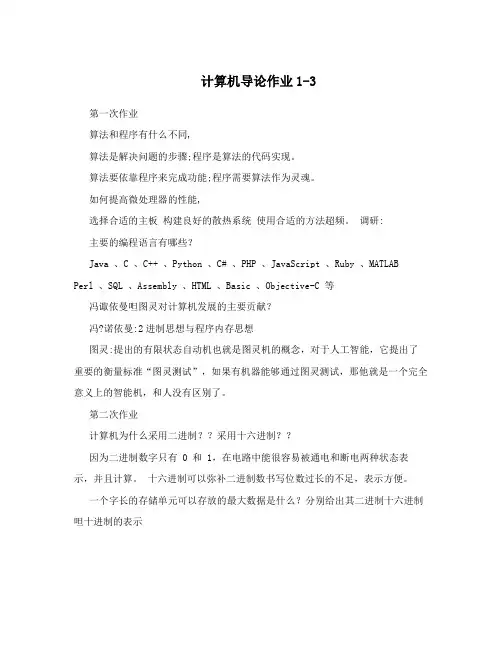
计算机导论作业1-3第一次作业算法和程序有什么不同,算法是解决问题的步骤;程序是算法的代码实现。
算法要依靠程序来完成功能;程序需要算法作为灵魂。
如何提高微处理器的性能,选择合适的主板构建良好的散热系统使用合适的方法超频。
调研:主要的编程语言有哪些?Java 、C 、C++ 、Python 、C# 、PHP 、JavaScript 、Ruby 、MATLABPerl 、SQL 、Assembly 、HTML 、Basic 、Objective-C 等冯诹依曼呾图灵对计算机发展的主要贡献?冯?诺依曼:2进制思想与程序内存思想图灵:提出的有限状态自动机也就是图灵机的概念,对于人工智能,它提出了重要的衡量标准“图灵测试”,如果有机器能够通过图灵测试,那他就是一个完全意义上的智能机,和人没有区别了。
第二次作业计算机为什么采用二进制??采用十六进制??因为二进制数字只有 0 和 1,在电路中能很容易被通电和断电两种状态表示,并且计算。
十六进制可以弥补二进制数书写位数过长的不足,表示方便。
一个字长的存储单元可以存放的最大数据是什么?分别给出其二进制十六进制呾十进制的表示在计算机中最小的信息单位是bit(字长),也就是一个二进制位,8个bit组成一个Byte,也就是字节。
一个存储单元可以存储一个字节,也就是8个二进制位。
即 11111111255,,ff,,,,,,21610如何加快数据的讵问速度??数据存放在内存戒者硬盘中,可以考虑使用高性能的内存条戒者硬盘。
SYBASE 、DB2 、ORACLE 、MySQL 、ACCESS 、MS SQL Server第三次作业2014.10.24.作业电脑不数码照相机戒摄像机如何交换数据,接口不原理,?在数码摄像机上常用的接口有两种,一种是 IEEE1394 接口,这是把照相机戒者摄像机上的内容下载到 PC 戒者非编工具上的必要接口,而另一种是 USB 接口,这主要是为了方便把存储卡上的内容下载到电脑上去。
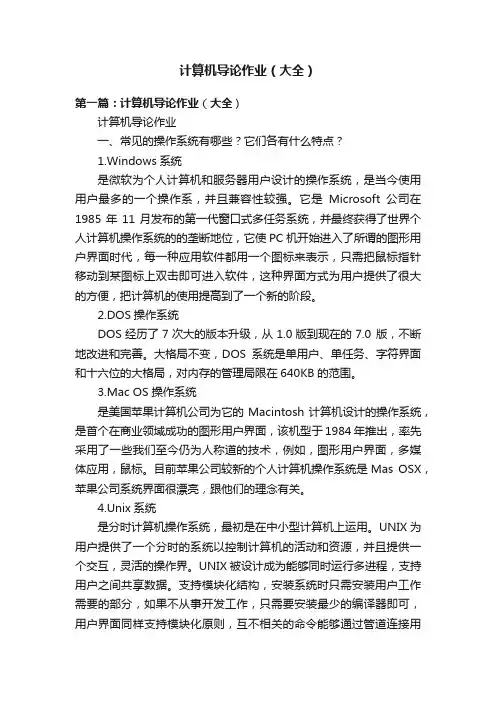
计算机导论作业(大全)第一篇:计算机导论作业(大全)计算机导论作业一、常见的操作系统有哪些?它们各有什么特点?1.Windows系统是微软为个人计算机和服务器用户设计的操作系统,是当今使用用户最多的一个操作系,并且兼容性较强。
它是Microsoft公司在1985年11月发布的第一代窗口式多任务系统,并最终获得了世界个人计算机操作系统的的垄断地位,它使PC机开始进入了所谓的图形用户界面时代,每一种应用软件都用一个图标来表示,只需把鼠标指针移动到某图标上双击即可进入软件,这种界面方式为用户提供了很大的方便,把计算机的使用提高到了一个新的阶段。
2.DOS操作系统DOS经历了7次大的版本升级,从1.0版到现在的7.0 版,不断地改进和完善。
大格局不变,DOS系统是单用户、单任务、字符界面和十六位的大格局,对内存的管理局限在640KB的范围。
3.Mac OS操作系统是美国苹果计算机公司为它的Macintosh计算机设计的操作系统,是首个在商业领域成功的图形用户界面,该机型于1984年推出,率先采用了一些我们至今仍为人称道的技术,例如,图形用户界面,多媒体应用,鼠标。
目前苹果公司较新的个人计算机操作系统是Mas OSX,苹果公司系统界面很漂亮,跟他们的理念有关。
4.Unix系统是分时计算机操作系统,最初是在中小型计算机上运用。
UNIX为用户提供了一个分时的系统以控制计算机的活动和资源,并且提供一个交互,灵活的操作界。
UNIX被设计成为能够同时运行多进程,支持用户之间共享数据。
支持模块化结构,安装系统时只需安装用户工作需要的部分,如果不从事开发工作,只需要安装最少的编译器即可,用户界面同样支持模块化原则,互不相关的命令能够通过管道连接用于执行非常复杂的操作。
5.Linux系统Linux是目前全球最大的一个自由免费软件,其本身是一个功能可与Unix和Windows相媲美,具有完备的网络功能,它的用法与UNIX 非常相似,几乎支持所有的硬件平台,是一个支持多用户多进程多线程和实时性较好且稳定的系统。
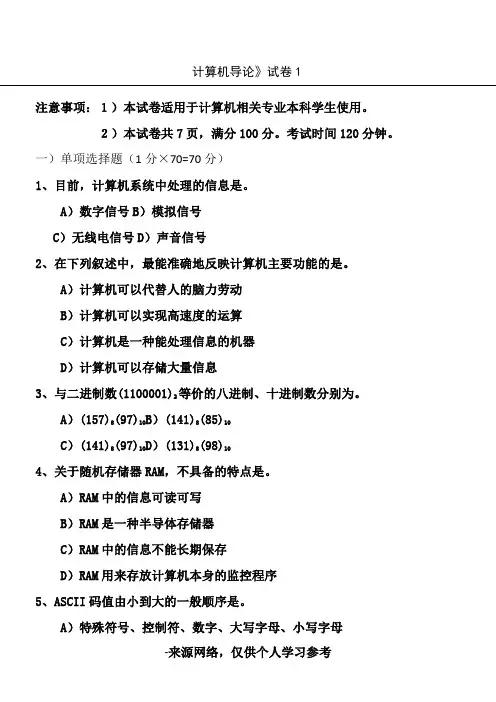
计算机导论》试卷1注意事项:1)本试卷适用于计算机相关专业本科学生使用。
2)本试卷共7页,满分100分。
考试时间120分钟。
一)单项选择题(1分×70=70分)1C234B)RAM是一种半导体存储器C)RAM中的信息不能长期保存D)RAM用来存放计算机本身的监控程序5、ASCII码值由小到大的一般顺序是。
A)特殊符号、控制符、数字、大写字母、小写字母B)控制符、特殊符号、数字、大写字母、小写字母C)大写字母、小写字母、数字、特殊符号、控制符D)数字、特殊符号、控制符、小写字母、大写字母6、扩展名为COM类文件为。
A)命令解释文件B)C语言源程序文件7891011、批处理操作系统是一个操作系统。
A)交互式B)分时C)非交互式D)网络式12、把高级语言的源程序变为目标程序要经过。
A)汇编B)编译C)编辑D)解释13、微机的性能指标中的内部存储器的容量是指。
A)RAM的容量B)ROM的容量C)硬盘的容量D)RAM和ROM的容量14、现代计算机之所以能自动连续进行数据处理,主要因为。
15、16171819、计算机一旦断电后中的信息会丢失。
A)硬盘B)软盘C)RAM D)ROM20、系统软件中最重要的是A)操作系统B)语言处理程序C)工具软件D)数据库管理系统21、总线是连接计算机各部分的一镞公共信号线,它是计算机中传送信息的公共通道,总线是由地址总线)数据总线和控制总线组成,其中地址总线是_在微机各部分之间传送的线路。
A)数据信号B)控制信号22AC23AC24AC2526、TCP/IP协议的含义是。
A)局域网传输协议B)拨号入网传输协议C)传输控制协议和网际协议D)OSI协议集27、Internet的域名结构中,顶级域名为Edu的代表。
A)商业机构B)政府部门C)教育机构D)军事部门28、电子邮件是A)网络信息检索服务。
B)通过Web网页发布的公告信息C)通过网络实时交互的信息传递方式29A)C)3031、A)C)32A)C)BitsPerSecondD)BillionPerSecond33、在因特网(Internet)中,电子公告板的缩写是。
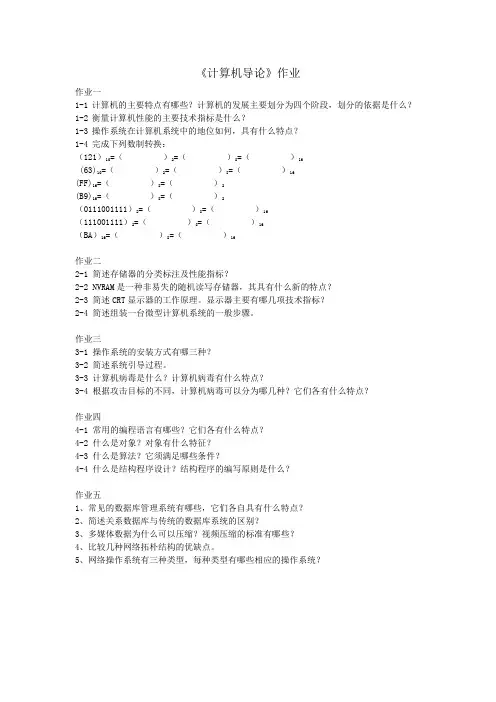
《计算机导论》作业作业一1-1计算机的主要特点有哪些?计算机的发展主要划分为四个阶段,划分的依据是什么?1-2衡量计算机性能的主要技术指标是什么?1-3操作系统在计算机系统中的地位如何,具有什么特点?1-4完成下列数制转换:(121)10=()2=()8=()16(63)10=()2=()8=()16(FF)16=()8=()2(B9)16=()8=()2(0111001111)2=()8=()16(111001111)2=()8=()16(BA)16=()8=()16作业二2-1 简述存储器的分类标注及性能指标?2-2 NVRAM是一种非易失的随机读写存储器,其具有什么新的特点?2-3 简述CRT显示器的工作原理。
显示器主要有哪几项技术指标?2-4 简述组装一台微型计算机系统的一般步骤。
作业三3-1 操作系统的安装方式有哪三种?3-2 简述系统引导过程。
3-3 计算机病毒是什么?计算机病毒有什么特点?3-4 根据攻击目标的不同,计算机病毒可以分为哪几种?它们各有什么特点?作业四4-1 常用的编程语言有哪些?它们各有什么特点?4-2 什么是对象?对象有什么特征?4-3 什么是算法?它须满足哪些条件?4-4 什么是结构程序设计?结构程序的编写原则是什么?作业五1、常见的数据库管理系统有哪些,它们各自具有什么特点?2、简述关系数据库与传统的数据库系统的区别?3、多媒体数据为什么可以压缩?视频压缩的标准有哪些?4、比较几种网络拓朴结构的优缺点。
5、网络操作系统有三种类型,每种类型有哪些相应的操作系统?《普通物理学》作业第一次作业:p.27一、一飞轮直径为0.2m,质量为5.00kg,边缘绕有一轻绳,现用恒力拉绳子的一端,使其由静止均匀地加速,经0.50s转速达10r/s。
假定飞轮可看做均质实心圆柱体。
求:1飞轮的加速度及在这段时间转过的转数;2拉力及拉力所做的功;3从拉动后t=10s时飞轮的角速度及轮边缘上一点的速度和切向加速度及法向加速度。
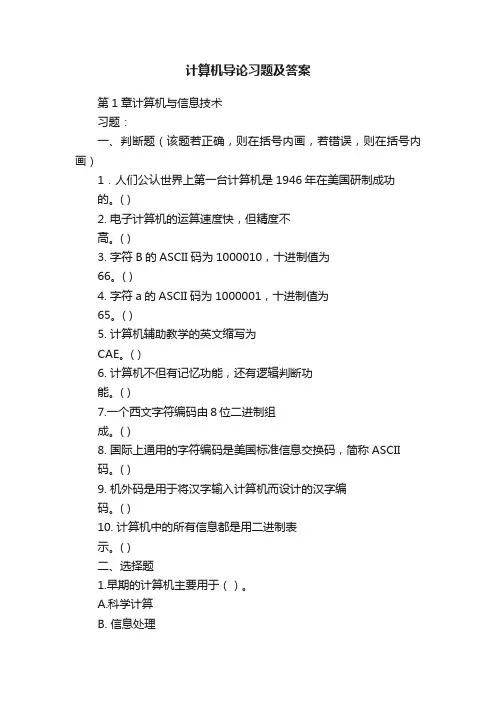
计算机导论习题及答案第1章计算机与信息技术习题:一、判断题(该题若正确,则在括号内画,若错误,则在括号内画)1.人们公认世界上第一台计算机是1946年在美国研制成功的。
( )2. 电子计算机的运算速度快,但精度不高。
( )3. 字符B的ASCII码为1000010,十进制值为66。
( )4. 字符a的ASCII码为1000001,十进制值为65。
( )5. 计算机辅助教学的英文缩写为CAE。
( )6. 计算机不但有记忆功能,还有逻辑判断功能。
( )7.一个西文字符编码由8位二进制组成。
( )8. 国际上通用的字符编码是美国标准信息交换码,简称ASCII码。
( )9. 机外码是用于将汉字输入计算机而设计的汉字编码。
( )10. 计算机中的所有信息都是用二进制表示。
( )二、选择题1.早期的计算机主要用于()。
A.科学计算B. 信息处理C. 实时监控 D. 辅助设计2.下面有关计算机特点的说法中,()是不正确的。
A. 运算速度快B. 计算精度高C. 所有操作是在人的控制下完成D. 随着计算机硬件设备和软件的不断发展和提高,计算机价格越来越高3.下列()为计算机辅助设计的英文缩写。
A. CADB. CAMC. CAID.CAE4.按照计算机采用的电子器件来划分,计算机的发展经历了()代。
A. 3B. 4C. 5D.65.目前计算机广泛应用于企业管理,它属于下列()类应用。
A. 实时控制B. 科学计算C. 数据处理D. 辅助设计6.下列一组数中最大的是()。
A. (266)8B. (111111)2C. (510)10D. (1FF)167.二进制数11001010转换为十进制数是()。
A. 203B. 200C. 202D. 2018.十进制数127转换为二进制数是()。
A. 1111111B. 10000000C. 1111110D. 100000019.数100H是()进制的数。
A. 二进制B. 十六进制C. 八进制D. 十进制10.目前使用的计算机采用()为主要的电子元器件。
本科第一次作业(第八周课程讲完之后交,用学院统一的作业纸书写,学院文印室有卖,要求抄题。
)1. 列举几个计算机在家用电器中的应用。
1 彩电、冰箱、洗衣机、空调、微波炉等家用电器中都能看到计算机的身影。
2. 计算机分为哪几代?每一代的代表性产品和主要特征是什么?(可以上网搜索)2 计算机可以分为四代:第一代1945-1956年,代表机型ENIAC、IBM650等,主要特征是以电子管作为主要逻辑器件。
第二代1956-1963年,代表机型IBM7000、CDC7600 等,主要特征是以晶体管作为主要逻辑器件。
第三代1964-1971年,代表机型IBM360。
主要特征是以中小规模集成电路作为主要逻辑器件。
第四代1971年—现在,代表机型使用微处理器4004以上的所有机型。
主要特征是以大规模和超大规模集成电路作为主要逻辑器件。
3. 教材44页第6题。
3① (121)10=(1111001)2=(171)8=(79)16② (366.625)10=(101101110.1010)2=(556.5)8=(16E.A)16③ (161.25)10=(10100001.01)2=(241.2)8=(A1.4)16④ (2562.75)10=(101000000010.11)2=(5002.6)8=(A02.C)16⑤ (369)10=(101110001)2=(561)8=(171)16⑥ (65535)10=(1111111111111111)2=(177777)8=(FFFF)16⑦ (512)10=(1000000000)2=(1000)8=(200)16⑧ (490)10=(111101010)2=(752)8=(1EA)164. 教材45页第7题。
4① 34 的原码为:00100010 补码为:00100010 反码为:00100010② -45的原码为:10101101 补码为:11010011 反码为:11010010③ 0 的原码为:00000000 补码为:00000000 反码为:00000000④ -1 的原码为:10000001 补码为:11111111 反码为:11111110⑤ 100的原码为:01100100 补码为:01100100 反码为:01100100⑥ -90的原码为:11011010 补码为:10100110 反码为:10100101⑦ 78 的原码为:01001110 补码为:01001110 反码为:01001110⑧ 88 的原码为:01011000 补码为:01011000 反码为:010110005. 教材45页第8题。
《计算机导论》试题参考答案一、名词解释题(4分/小题,共20分)1.数据结构答:数据结构是指具有一定结构(关系)的数据元素的集合,区分为数据的逻辑结构——数据的逻辑关系,和物理(存储)结构——数据在存储器中的存储结构。
2.计算机病毒答:一种对系统运行产生危害(破坏数据和文件、耗用系统资源等)的计算机程序,这种程序具有传染(自我复制)能力。
3.操作系统答:用于管理和控制计算机系统的硬件资源和程序的运行,提高资源利用率,方便用户操作使用计算机的一组程序的集合。
4.计算机网络答:用传输介质连接起来的具有自主运行能力的计算机系统的集合,其主要用途是实现数据传输(交换)与资源共享。
5.剪贴板答:由操作系统负责管理的一部分内存区域,用于在一个应用内部或不同的应用之间交换数据(相当于数据的中转站)。
二、单项选择题(1分/小题,共15分)1.A 2.D 3.B 4.B 5.C6.D(10110010) 7.C 8.B 9.B 10.C11.C 12.B 13.C 14.B 15.A三、多项选择题(2分/小题,共20分) 1.ABCD 2.ABD 3.BD 4.ABD 5.BD6.ABCD 7.BCD 8.AC 9.ABD 10.ABCD四、判断题(1分/小题,共10分)1.√2.√3.Ⅹ4.√5.Ⅹ6.√7.Ⅹ8.√9.Ⅹ10.√五、简述题(7分/小题,共35分)1.简要叙述用计算机解决实际问题的步骤。
答:(1) 建立实际问题的数学模型;(2) 确定求解问题的算法;(3) 编程;(4) 调试程序;(5) 运行程序,得到问题的结果。
2.简述运算器中标志寄存器的作用。
答:给出所执行指令执行结果的一些特征,以便直接后继指令根据情况进行处理。
3.简述从磁盘上读取文件内容的基本原理。
答:(1) 检索文件目录,从目录中读取文件的首簇号;(2) 根据簇号到磁盘上读取文件内容;(3) 从FA T中当前簇对应的表项中读取下一簇号;(4) 若不是结束标志,就转(2),否则,文件读取完毕。
大工17春《计算机科学导论》在线作业1答案作业1题目:编程题1. 编写程序,输出1-100之间的所有素数。
解答代码如下:def is_prime(num):if num < 2:return Falsefor i in range(2, int(num**0.5) + 1):if num % i == 0:return Falsereturn Truedef print_primes():primes = []for num in range(1, 101):if is_prime(num):primes.append(num)return primesprimes = print_primes()print(primes)2. 编写程序,求用户输入的任意正整数的阶乘。
解答代码如下:def factorial(num):result = 1for i in range(1, num + 1):result *= ireturn resultnum = int(input("请输入一个正整数:")) factorial_result = factorial(num)print(f"{num}的阶乘为:{factorial_result}")3. 编写程序,判断用户输入的字符串是否为回文字符串。
解答代码如下:def is_palindrome(string):string = string.lower()reversed_string = string[::-1]if string == reversed_string:return Trueelse:return Falsestring = input("请输入一个字符串:")if is_palindrome(string):print("是回文字符串")else:print("不是回文字符串")以上是《计算机科学导论》在线作业1的答案,希望对您有帮助。
计算机导论第一次作业计算机导论课第一次作业根据你自己的理解回答下列问题:第一题:尝试回答你自己对计算、计算机、计算机科学的理解。
1.计算是一种将零个或多个输入值转换为一个或多个结果(输出值)的思考过程。
2.计算机是能够实现计算过程的机器、工具。
是由一系列电子元器件组成的,能进行数值计算和信息处理的机器;是一种能自动、高速、精确地对信息进行存储、传送和加工处理的工具。
3.计算机科学是研究计算机及其周围各种现象和规律的科学;亦即是研究计算机系统结构、程序系统(即软件)、人工智能以及计算本身的性质和问题的学科。
第二题:尝试回答计算机的特点、计算机的发展趋势。
计算机特点:运算速度快,计算精确度高,记忆能力强,具有逻辑判断能力,有自动控制能力计算机发展趋势1 巨型化发展高速度,大存储容量,强功能的超大型计算机。
2 微型化是以大规模集成电路为基础的计算机微型化。
3 网络化用通信线路及通信设备把个别的计算机连接在一起形成一个复杂的系统就是计算机网络。
现今最大的网络是Internet;加入这个网络的计算机已达数亿台。
4 智能化是指计算机具有模仿人类较高层次智能活动的能力。
5 多媒体化将文字、声音、图形、图像、视频等多种媒体与计算机集成在一起来设计与处理第三题:简述图灵其人、其事;其对计算机科学发展的贡献。
阿兰·麦席森·图灵Alan Mathison Turing。
1912年6月23日,出生于英国伦敦,是英国著名的数学家和逻辑学家,被称为计算机科学之父、人工智能之父,计算机逻辑的奠基者。
理论--“图灵机”,理论--“图灵测试”,为了纪念图灵—“图灵奖”。
图灵机,是英国数学家阿兰·图灵于1936年提出的一种抽象计算模型,其更抽象的意义为一种数学逻辑机。
--是计算机理论模型。
图灵机构成:1、一条无限长的纸带TAPE。
2、一个读写头HEAD。
3、一套控制规则TABLE。
4、一个状态寄存器。
国开电大形考作业答案 - 计算机导论 - 形考任务11. 引言形考任务1要求回答计算机导论课程相关的选择题,涵盖计算机科学和计算机技术的基本概念、发展历程、硬件和软件等方面的内容。
本文将逐题解析并给出详细的答案和解释。
2. 选择题2.1 问题1计算机的核心部件是()。
A. 显卡B. CPUC. 主板D. 内存答案及解析正确答案是B. CPU(中央处理器)。
计算机的核心部件是中央处理器,它负责执行计算机的指令和控制计算机的操作。
显卡是负责显示图像的部件,主板是连接各个硬件部件的主要电路板,内存是用于存储数据和程序的临时存储器。
2.2 问题2计算机内存的作用是()。
A. 存储数据和程序B. 控制计算机的操作C. 进行计算和运算D. 显示图像答案及解析正确答案是A. 存储数据和程序。
计算机内存用于存储数据和程序,在计算机运行过程中,数据和程序都需要被加载到内存中才能进行处理。
控制计算机的操作是中央处理器(CPU)的功能,计算和运算是CPU执行的基本任务,显示图像是显卡的功能。
2.3 问题3以下哪个选项描述了计算机网络的概念?A. 计算机电路的集合B. 通过通信链路连接在一起的计算机和外部设备的集合C. 存储器和中央处理器D. 硬盘和显示器答案及解析正确答案是B. 通过通信链路连接在一起的计算机和外部设备的集合。
计算机网络是指通过通信链路(如以太网、无线网络等)连接起来的多台计算机和外部设备的集合。
计算机电路是计算机内部的电路部分,存储器和中央处理器是计算机硬件的组成部分,硬盘和显示器是计算机的外部设备之一。
2.4 问题4计算机软件分为()。
A. 系统软件和应用软件B. 硬件和软件C. 操作系统和设备驱动程序D. 编辑器和编译器答案及解析正确答案是A. 系统软件和应用软件。
计算机软件分为系统软件和应用软件两大类。
系统软件是操作系统、设备驱动程序等控制计算机硬件并管理计算机资源的软件。
应用软件是指用户可以直接使用的各种应用程序,例如文字处理软件、电子表格软件等。
Test Bank—Chapter One (Data Representation)Multiple Choice Questions1. Which of the following Boolean operations produces the output 1 for the fewest number of input patterns?A. ANDB. ORC. XORANSWER: A2. Which of the following best describes the NOR operation?A. An XOR followed by a NOTB. An OR followed by a NOTC. A NOT followed by a NOT C. An AND followed by a NOTANSWER: B3. Which of the following bit patterns cannot be expressed in hexadecimal notation?A. 11111111B. 1001C. 110011D. 100000000001ANSWER: C4. Which of the following is the binary representation of 4 5/8?A. 100.11B. 10.011C. 110.101D. 100.101ANSWER: D5. Which of the following bit patterns represents the value 5 in two’s complement notation?A. 00011010B. 11111011C. 00000101D. 11111011ANSWER: C6. Which of the following bit patterns represents the value -5 in two’s complement notation?A. 00011010B. 11111011C. 00000101D. 11111011ANSWER: D7. In which of the following addition prob lems (using two’s complement notation) does an overflow error occur?A. 0011B. 0100C. 1100+ 1010 + 0100 + 1100ANSWER: B8. Which of the following representations in two’s complement notation represents the largest value?A. 00000010B. 11111111C. 00000001D. 11111110ANSWER: A9. Which of the following bit patterns (represented in hexadecimal notation) represents a negative number in two’s complement notation?A. 7FB. 55C. A6D. 08ANSWER: C10. What value is represented by the bit pattern 01011100 when interpreted using floating-point format in which the most significant bit is the sign bit, the next three bits represent the exponent field in excess notation, and the last four bits represent the mantissa?A. -1 1/2B. 1 1/2C. -3/8D. 3/8ANSWER: B11. Which of the following values cannot be stored accurately using a floating-point format in which the most significant bit is the sign bit, the next three bits represent the exponent field in excess notation, and the last four bits represent the mantissa?A. 2 1/2B. 3/16C. 7D. 6 1/4ANSWER: D121. Which of the following bit-patterns represents the smallest value using the floating-point format in which the most significant bit is the sign bit, the next three bits represent the exponent field in excess notation, and the last four bits represent the mantissa?A. 01001000B. 01011000C. 00101000D. 01111000ANSWER: C13. Which of the following data storage systems provides the most efficient random access to individual data items?A. Main memoryB. Magnetic diskC. Optical CDs and DVDsANSWER: A14. Which of the following storage systems is best suited for storing and retrieving long strings of data that are processed in their sequential order?A. Main memoryB. Magnetic diskC. Optical CDs and DVDsANSWER: C15. Which of the following mass storage system does not require physical motion?A. Magnetic tapeB. Magnetic diskC. DVDsD. Flash drives ANSWER: D16. Assuming that each of the following bit patterns originally had even parity, which one contains an error?A. 10110100B. 11000011C. 00011000D. 10001001 ANSWER: D17. How many errors per pattern could be corrected when using an error-correcting code in which any two code patterns differ by a Hamming distance of 8?A. 3B. 4C. 5D. 6ANSWER: A18. Which of the following is a possible LZW compression of the message “xyz xyz xyz”?A. 1234B. 1234545C. 232D. 12ANSWER: B19. How many different symbols can be encoded using Unicode?A. 256B. 4,096C. 65,536D. 1,046,476ANSWER: C20. Which of the following systems is least efficient when encoding numeric values?A. Two’s complement notationB. Excess notationC. ASCIID. Floating-point notationANSWER: C21. Which of the following is a means of encoding music?A. ASCIIB. MIDIC. JPEGD. GIFANSWER: BFill-in-the-blank/Short-answer Questions1. A computer’s main memory consists of numerous memory cel ls, each of which contains ________ bits. Each memory cell is identified by a numeric value called the cell’s _________.ANSWER: eight, address2. Represent the bit pattern 1011010010011111 in hexadecimal notation._________ANSWER: B49F3. A7DF is the hexadecimal representation for what bit pattern?____________ANSWER: 1010 0111 1101 11114. How many different bit patterns can be formed if each must consist of exactly 6 bits?____________ANSWER: 645. Translate each of the following binary representations into its equivalent base ten representation.A. 1100 __________B. 10.011 __________C. 0.01 __________D. 10001 __________ANSWER: A. 12 B. 2 3/8 C. 1/4 D. 176. Rewrite each of the following values (represented in base ten notation) in binary notation.A. 7 __________B. 23 __________C. 2 1/4 __________D. 5/8 __________ANSWER: A. 111 B. 10111 C. 10.01 D. 0.1017. If the patterns 101.11 and 1.011 represent values in binary notation, what is the binary representation of their sum?____________ANSWER: 111.0018. Using a two’s complement notation system in which each value is represented by a pattern of six bits, represent the value 3.____________ANSWER: 0000119. Using a two’s complemen t notation system in which each value is represented by a pattern of six bits, represent the value -3.____________ANSWER: 11110110. What is the largest positive integer that can be represented in a two’s complement system in which each value is represented by eight bits?____________ANSWER: 127 (represented by 01111111)11. In a two’s complement system, what value is represented by the pattern 11111111111111001?____________ANSWER: -712. When using two’s complement notation, what bit pat tern represents the negation of 01101010?____________ANSWER: 1001011013. What value is represented by each of the following patterns in excess notation?A. 10000 ____B. 0110 ____C. 1011 ____ANSWER: A. 0, B. -2, C. 314. Using an 8-bit floating-point format in which the most significant bit is the sign bit, the next three bits represent the exponent field in excess notation, and the last four bits represent the mantissa, write the bit pattern that represents the value 1 3/4. (Use normalized form.)____________ANSWER: 0101111015. What is the largest value that can be represented in a floating-point system in which each value is encoded by a byte whose most significant bit is the sign bit, the next three bits represent the exponent field in excess notation, and the last four bits represent the mantissa?____________ANSWER: 7 1/2 (represented as 01111111)16. Which of the following addition problems cannot be solved accurately when using a floating-point system in which each value is encoded by a byte whose most significant bit is the sign bit, the next three bits represent the exponent field in excess notation, and the last four bits represent the mantissa?A. 2 1/2 + 1 3/8B. 3 1/2 + 4 1/2C. 7 + 3/4____________ANSWER: A, B, and C17. The following is an error-correcting code in which any two patterns differ by a Hamming distance of at least three.Symbol RepresentationA 000000B 001111C 010011D 011100E 100110F 101001G 110101H 111010Decode each of the following patterns010011 ________ 101010 ________ 011000 ________ 101101 _______ ANSWER: C, H, D, F18. How many errors in a single code pattern could be corrected when using an error-correcting code in which each code pattern is a Hamming distance of at least seven from any other code pattern?____________ANSWER: 319. The following is a message that was originally encoded so that each pattern had odd parity. Circle the patterns in which an error has definitely occurred.10110101 11110000 10010010 00000000 11111111 00001000 00111101______________________________________ANSWER: Second, fourth, fifth, and sixth20. Data compression techniques apply various principles to reduce the size of data. One, called_______________________, avoids repeating long strings of the same data item. Another, called_______________________, encodes the difference between consecutive blocks of data rather than encoding each block in its entirety. Still another, called _________________________, uses short bit patterns to encode frequently occurring items and longer patterns to encode less frequent items. ANSWER: Run-length encoding, relative encoding, and frequency-dependent encoding.Vocabulary (Matching) QuestionsThe following is a list of terms from the chapter along with descriptive phrases that can be used to produce questions (depending on the topics covered in your course) in which the students are ask to match phrases and terms. An example would be a question of the form, “In the blank next to each phrase, write the term from the following list that is best described by the phrase.”Term Descriptive Phrasebit Binary digitBoolean operation AND, OR, XOR, NOTaddress A numeric value used to identify a memory cellhexadecimal notation An efficient way of representing bit patternssector A segment of a track in a mass storage systemzoned-bit recording A means of increasing the storage capacity of a magnetic disk system buffer A storage area used to hold data on a temporary basis, often as a stepin transferring the data from one device to anotherISO An international organization for establishing standardsANSI A major standardization organization within the United StatesASCII A system developed by the American Standards Institute for encodingtext.flip-flop A digital circuit capable of holding a single digittwo’s complement notation A means of encoding whole numbersfloating-point notation A means of encoding numeric values that may involve fractions truncation An error that may occur when using floating-point notationpixel A small part of an imageGIF A means of compressing an image file by restricting the number ofcolors availableJPEG A means of compressing images by blurring the boundaries betweendifferent colors while maintaining all brightness informationUnicode A means of encoding text in which each symbol is represented by 16bitsLZW An example of adaptive dictionary encodingMIDI A means of encoding music in terms of notes and instruments ratherthan actual audioKey field A part of a logical record in a file used to identify the record.VLSI A means of constructing complex circuitry in a very small space.General Format Questions1. Describe how a computer can produce an incorrect answer when performing numerical computations even though it has not malfunctioned.ANSWER: Most students will probably refer to overflow and truncation errors.2. Describe ho the concept of Hamming distance is used to produce an error-correcting code. ANSWER: By designing a code in which each pattern has a Hamming distance of n from any other pattern, patterns with fewer than n/2 errors can be corrected by replacing them with the code pattern that is closest.3. a. What is the output of the circuit below?b. In general, how does the three-bit input pattern acros s the top of the diagram relate to the circuit’s output?ANSWER: a. 0 b. The output is 0 if the input parity is odd; the output is 1 if the input parity is even.4. If the input and output bit patterns in the circuit below are interpreted as binary representations of numeric values, what operation does the circuit perform?ANSWER: The circuit subtracts one (except for the case of the input being 000).5. Explain why such terms as kilobyte, megabyte, and gigabyte have acquired double meanings.ANSWER: The prefixes kilo, mega, and giga are used traditionally to refer to units measured in powers of ten. However, due to the early misuse of the prefix kilo in reference to units of the size 1024, these prefixes are now often used to refer to units that are powers of two—especially when referring to the capacity of main memories.6. Convert the following addition problem into two’s complement notation (using four bits per value), perform the addition, convert the answer back into base ten notation, and explain the results.6+ 3ANSWER: In two’s complement notation the problem is to add 0110 and 0011. The sum is 1001 which translates to -7. This answer is incorrect due to overflow.7. Under what condition is each of the following data compression techniques most effective?a. Run-length encodingb. Relative encodingANSWER: a. Compresses most when data consists of long strings of the same entry.b. Compresses most when each block of data differs little from the previous block.8. What is frequency-dependent encoding?ANSWER: Frequency-dependent encoding is an encoding system that uses short bit patterns to represent data items that occur most often and longer patterns to represent less frequently occurring items. The result is that entire blocks of data can be represented in less space than would be required if each data item were represented by the same size bit pattern.9. Construct the entire two’s complement scale in which each value is represented by three bits.ANSWER: 3 0112 0101 0010 000-1 111-2 110-3 101-4 10010. To what does the term “normalized form” refer in the context of floating-point notation?ANSWER: Normalized form refers to a standard for positioning the bit pattern within the mantissa field. Many values can be represented in floating-point notation by different bit patterns, only one of which is in normalized form. Hence, restricting representations to normalized form assures that each value is represented by a unique pattern.11. Explain why the final version of the dictionary need not be transmitted with a message encoded using LZW compression.ANSWER: The dictionary can be constructed during decompression in the same way it was constructed during compression.12. Among the Boolean operations AND, OR, EXCLUSIVE OR, and NOT, which is least like the others? Explain your answer.ANSWER: There is not really a right or wrong answer. The student’s explanation is the most important part. Most students will probably answer NOT because it has only one input whereas the others have two.13. If a term paper consisted 42 pages, each containing 40 lines of 100 symbols each (counting each space asa symbol), was to be encoded using Unicode, how many bytes of storage space would be required?ANSWER: 336,000 bytes (168,000 symbols times 2 bytes per symbol)14. Explain why adding only a few characters to a text file may increase the file’s size by several hundred bytes and at other times may not increase the file’s s ize at all.ANSWER: File space is allocated in terms of physical records, each of which is several hundred bytes in size. Thus, the size of a file grows by physical record units rather than by byte size units.15. In a two’s complement system, what valu e can be added to any other value without causing an overflow? How many values in the system have this property? Explain your answer.ANSWER: Adding the value 0 to any other value will not produce an overflow. However, if m is the largest positive integer that can be represented in the system, then any value in the range 1 to m will produce an overflow when added to m, and any value in the range -1 to -( m + 1) will produce an overflow when added to -( m + 1).。